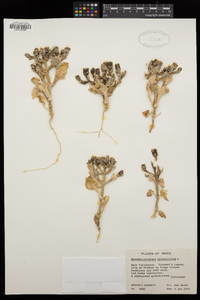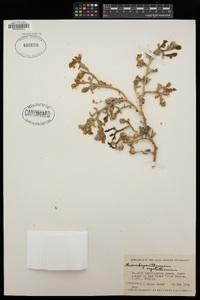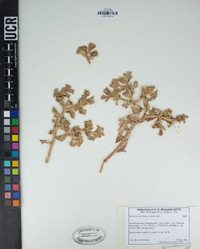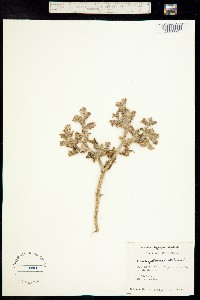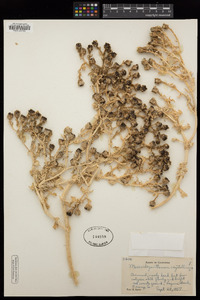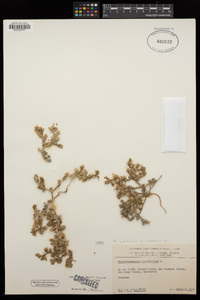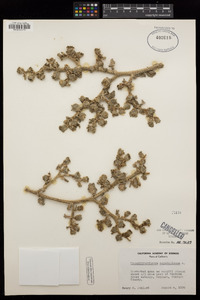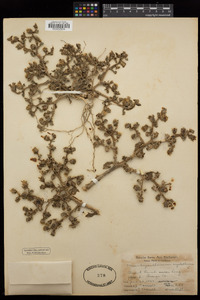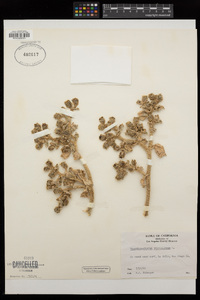Mesembryanthemum crystallinum
|
|
|
|
Family: Aizoaceae
common iceplant, more...Crystalline Iceplant, crystalline ice plant, ice plant (es: hielitos)
[Cryophytum crystallinum (L.) N.E. Br., moreGasoul crystallinum (L.) Rothm.] |
Plants annual to biennial. Stems trailing, dichotomously branched, to 1 m. Leaves sessile or petiolate; petiole, ± clasping; blade ovate to spatulate, flat, 2-20 cm, margins undulate. Inflorescences terminal or axillary, cymes; proximal bracts opposite, leaflike; distal bracts alternate, reduced; flowering profusely. Flowers 7-10 mm diam.; hypanthium aging red, round; calyx lobes 5, unequal; petals 20-40, connate into tube, white, aging pink; stamens 30. Capsules coarsely papillate. Seeds 200, rough with minute tubercles. 2n = 18. Flowering year-round, mostly spring-fall. Coastal bluffs, cliffs, ballast dumps, disturbed ground; 0-100 m; introduced; Ariz., Calif., Pa.; Mexico (Baja California); South America; Europe (Mediterranean); Africa; Atlantic Islands; Australia. Introduced from southern and western Africa, Mesembryanthemum crystallinum is in cultivation as an ornamental. Its use to treat scurvy by sailors, its popularity as an ornamental potted plant aboard ships, and its occurrence in ballast dumps (as in Pennsylvania) were some of the means by which this species has become so widespread throughout the world. Gauchos in Argentina used it to treat venereal disease.
General: Introduced herbaceous annuals to perennials, to 1 m long, stems trailing, succulent, dichotomously branched, herbage usually conspicuously papillate, glabrous. Leaves: Opposite or alternate, blades flattened, ovate to spatulate, 2-20 cm long, sessile or petiolate, if petiolate then more or less clasping, margins undulate, blades often becoming reddish with age. Flowers: White, aging pink, 7-10 mm in diameter, petals 20-40, connate into tubes, calyx lobes 5, unequal, hypanthium round, aging red, stamens 30, flowers borne in terminal or axillary cymes, with proximal bracts opposite and leaflike and distal bracts alternate and reduced. Fruits: Capsules coarsely papillate. Seeds 200, rough with minute tubercles. Ecology: Found on coastal bluffs, cliffs, ballast dumps, disturbed ground, from 0-350 ft (0-106 m); flowering year-round, mostly spring-fall. Distribution: Introduced. Widespread throughout the United States. Notes: This sturdy little ice plant is generally an escaped cultivar, and forms dense mats with pink or white flowers. Look to the flattened leaf blades and the flowers 7-10 mm in diameter to help distinguish this species from the similar M. nodiflorum, which has terete leaf blades and smaller flowers, these 4-5 mm in diameter. FNA notes that; “Introduced from southern and western Africa, M. crystallinum is in cultivation as an ornamental. Its use to treat scurvy by sailors, its popularity as an ornamental potted plant aboard ships, and its occurrence in ballast dumps (as in Pennsylvania) were some of the means by which this species has become so widespread throughout the world.” Ethnobotany: Unknown Etymology: Mesembryanthemum is either; (1) derived from 2 words: mesos, “middle,” and embryon, “fruit,” indicating a flower with its fruit in the middle, and/or (2) afternoon-blooming. The original name was Mesembrianthemum, from mesembria or “mid-day” alluding to the belief that the species only bloomed in the sunlight. After night-blooming species were discovered, the spelling of the name was changed to its current form, while crystallinum means crystalline, referring to the many ice-like bubbles on the herbage. Sources: FNA 2004 FNA 2004 Duration: Annual Nativity: Non-Native Lifeform: Forb/Herb General: Introduced herbaceous annuals to perennials, to 1 m long, stems trailing, succulent, dichotomously branched, herbage usually conspicuously papillate, glabrous. Leaves: Opposite or alternate, blades flattened, ovate to spatulate, 2-20 cm long, sessile or petiolate, if petiolate then more or less clasping, margins undulate, blades often becoming reddish with age. Flowers: White, aging pink, 7-10 mm in diameter, petals 20-40, connate into tubes, calyx lobes 5, unequal, hypanthium round, aging red, stamens 30, flowers borne in terminal or axillary cymes, with proximal bracts opposite and leaflike and distal bracts alternate and reduced. Fruits: Capsules coarsely papillate. Seeds 200, rough with minute tubercles. Ecology: Found on coastal bluffs, cliffs, ballast dumps, disturbed ground, from 0-350 ft (0-106 m); flowering year-round, mostly spring-fall. Distribution: Introduced. Widespread throughout the United States. Ethnobotany: Unknown Synonyms: Cryophytum crystallinum Editor: LCrumbacher 2012 Etymology: Mesembryanthemum is either; (1) derived from 2 words: mesos, "middle," and embryon, "fruit," indicating a flower with its fruit in the middle, and/or (2) afternoon-blooming. The original name was Mesembrianthemum, from mesembria or "mid-day" alluding to the belief that the species only bloomed in the sunlight. After night-blooming species were discovered, the spelling of the name was changed to its current form, while crystallinum means crystalline, referring to the many ice-like bubbles on the herbage. |
|
|
|











